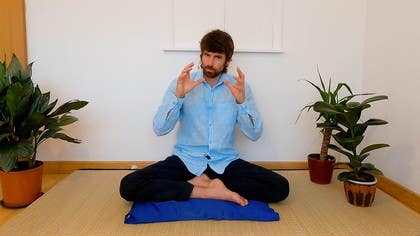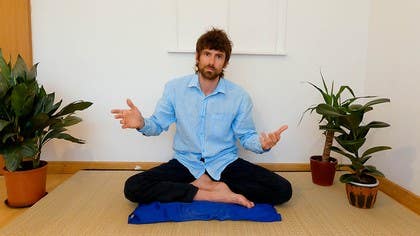Description
About This Video
Transcript
Read Full Transcript
So, Patanjali has told us that if, at the end of chapter one, Patanjali has told us all about Samadhi, but if we've come to the end of chapter one and we're not fully established in Samadhi, in his great humanity, he has now begun to lay out the method of sadhana, the way of practical yogic exploration and active practice, to help us cultivate that Samadhi and reduce the afflictions, the cliches. So he said the basic method has these three constituent foundational elements, tapa, the steady, illuminating, warming, fire of yogic balanced discipline, svaadhyaya, that constant ongoing curiosity, exploration, inquiry into ourselves and ultimate reality, and Ishwarapranidhana, this concept, this principle of consecrating our actions to something greater than what we think we are. When we work with these principles, they can help us cultivate Samadhi and attenuate the cliches, and Patanjali has told us from sutra's four to nine about the cliches, these afflictions that flesh is heir to. And then he's begun to tell us how we can overcome the tendency for these cliches to get in the way and afflict us and stop us experiencing that Samadhi and that recognition of who you really are. So in sutra number 10, having told us the problem, if you like, of the cliches, the afflictors, he then tells us the solution or begins to go into depth on this solution.
So sutra 10, the, those cliches, pratiprasava heya suksmaha, they can be overcome, they can be nipped in the bud, as it were, by taking our awareness back to the source. We're going to hear a lot more about this as the chapter continues. Dhyana hyahas tad vrittaya ha. And when the cliches are operating, then the means to overcome them is dhyana, meditative practice, this constant effort to cultivate steadiness can help us start to unveil these afflicting barriers that stop us recognising who we are. Then in sutra 12, and we'll look at 12, 13 and 14 together now.
So in the 12th sutra, it potentially says, klesha mula karamah shayo drishta drishta janmavir nihya. And in the 13th sati mule tatvipa ko jatya yur bhoga. So in the 12th, klesha mula, so mula means the root. So the root of the cliches, karamah shayo drishta adrishta, drishta adrishta, so jahnmavir nihya. So jahnm means birth, vedaniya will be known in births that adrishta and adrishta.
Birth life spans, life experiences that are known and not known. So what does this basically mean? Klesha mula, the root of the cliches is the karamah shayo. Now the karamah shayaha basically means the vehicle of karma. So as long as we have a storehouse of karmas, of actions that need to have their equal and opposing reactions balanced out, then we're going to keep getting born.
In the 13th sutra, Pitanjali says sati mule tatvipa ko jatya yur bhoga. Sati mule as long as the root is there. As long as we still are experiencing karma with an R and karma without an R, karma meaning actions and their consequences, and karma desires, as long as we have a desire to experience more things, as long as we have karmas that need to be worked out, then we're going to get born again. Born with a vehicle, a bodily vehicle, that is the vehicle in which this accumulated storehouse of karmas and their imprints and their ensuing desires will get played out in and through. So in other words, as long as there are karmas that need to be harmonised, dealt with, clarified, cleansed, as long as we have desires, this is going to make, it's going to produce if we like, more bodies, more births, in which we can work all that out.
Sati mule tatvipa ko jatya yur bhoga. And how does that happen? So as long as the root is there, it will blossom, it will grow, those roots will come to fruition and bring about our jati, which means the situation state classification, if you like, of our birth, so what type of species we might be, what type of, if we're born as a human being, which is what this is really about, what type of life situation will we find ourselves in, what will our family be like, what will our circumstances be like as we're growing up, jati, and then we have ayuhu, how long will we live, what will our lifespan be like, and then bhoga, now bhoga means enjoyment and things that help us learn. So depending on the root, that's going to determine how it blossoms and fruits. As long as the root is there to want more of life, then that is going to bring us into a situation in which we can work out our karmas and have these different types of experience that can help us meet and fulfill the desires we have been harbouring and work out our karmas.
And this will continue as long as that root, that seed is there. And it will come to fruition in the state or situation of our birth, how long our life will be, and what types of enjoyable and educational, which may be enjoyable or not, experiences we will encounter in this life. And then in the 14th, Patanjali says, how will these fruition be, how will these births be, those taking births, those fruition of this still existing root and seed, it will be paritapa or it will be hlada, so paritapa means very painful, it will be not pleasant and hlada, joyful. Depending on whether the action that has caused it, the root that is now coming to fruition was punya, virtuous, or apunya, not virtuous. So as a person sows, so shall that person reap, is the basic idea that is encoded here.
And so we might have the idea, okay great, well I'll just do good things then, and then I will have joyful births, a lovely situation, a very pleasant agreeable lifespan and I'll die feeling ready, having had a very enjoyable and educational lifespan in which I can realise and fulfil all my deep longings, desires and dreams. Tihlada, paritapa, palav, punya, punya hetudvat, so certainly it's a very good policy and Patanjali and yoga encourages us to always, as best as we can, cultivate harmony. This is one of the foundational practices in yoga, however, we are human beings, we've put two eyes, we can only see a tiny sliver of the vast spectrum of reality of which we are part, and so sometimes we may, with very good intentions, cause harm. Sometimes without making any effort to, we may actually help other people or help the balance of the cosmos, but we might not realise it. The ways of karma, Krishna says in the Bhagavad Gita, are beyond fathoming, they are so deep.
So of course, yes, let us cultivate harmony. This is going to bring us more pleasant fruits, more pleasant results, generally speaking. However, as Patanjali will now go on in the 15th sutra, as long as we're a human being, it's absence of suffering isn't really so likely a type of life experience. So how are we going to deal with that? This is where we'll continue.







You need to be a subscriber to post a comment.
Please Log In or Create an Account to start your free trial.